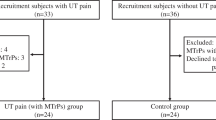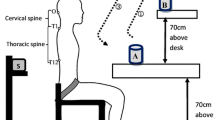Abstract
This study aimed at investigating whether patients with neck–shoulder complaints from different aetiologies (work-related musculo-skeletal disorders, WMSD; whiplash associated disorders, WAD) show comparable muscle activation patterns, characterised by higher activation and lower relaxation levels of the trapezius muscles compared to healthy controls. Twenty healthy controls, 21 WMSD and 20 WAD patients with non-acute neck-shoulder pain were recruited for this cross-sectional study. Surface electromyography (sEMG) recordings were performed at the upper trapezius muscles during reference contractions, standardised computer tasks (typing and unilateral stress task), and rest measurements. sEMG was continuously recorded during these measurements. Outcome measures were root mean square (RMS) to study muscle activity, and relative rest time (RRT) to study muscle relaxation. Statistical analysis comprised the bootstrap technique and Kruskall–Wallis tests. Results showed no clear evidence for abnormal muscle activation patterns in WMSD and WAD patients compared to healthy controls. However, a tendency was observed for higher RMS levels during the reference contractions and computer tasks in both patient groups compared to healthy controls, and lower RRT levels at the non-dominant side during stress. Both patient groups also showed larger variability in RMS and RRT values. This variability has more often been reported in literature and may suggest the existence of subgroups of pain patients with corresponding different muscle activation patterns not related to aetiology. Future research may focus on identifying these subgroups of patients with neck-shoulder pain.



Similar content being viewed by others
References
Barr AE, Barbe MF (2002) Pathophysiological tissue changes associated with repetitive movement: a review of the evidence. Phys Ther 82(2):173–187
Basmajian J, de Luca C (1985) Muscles alive. Their functions revealed by electromyography, 5 edn. Williams & Wilkins, Baltimore
Blatter B, Bongers PM (1999) Work related neck and upper limb symptoms (RS): high risk occupations and risk factors in the Dutch working population. Report 4070117/r9800293. TNO Work and Employment, Hoofddorp
Blatter B, van den Heuvel SG, Bongers PM, Picavet HSJ, Schoemaker CG (2001) De omvang van verzuim en arbeidsongeschiktheid door RSI. Report R2014889/1020123. TNO Work and Employment, Hoofddorp
Brandt LP, Andersen JH, Lassen CF, Kryger A, Overgaard E, Vilstrup I, Mikkelsen S (2004) Neck and shoulder symptoms and disorders among Danish computer workers. Scand J Work Environ Health 30(5):399–409
Brault JR, Siegmund GP, Wheeler JB (2000) Cervical muscle response during whiplash: evidence of a lengthening muscle contraction. Clin Biomech 15(6):426–435
Elert J, Kendall SA, Larsson B, Mansson B, Gerdle B (2001) Chronic pain and difficulty in relaxing postural muscles in patients with fibromyalgia and chronic whiplash associated disorders. J Rheumatol 28(6):1361–1368
Efron B, Tibshirani RJ (1993) An introduction to the Bootstrap. Chapman and Hall, New York
Falla D, Bilenkij G, Jull G (2004) Patients with chronic neck pain demonstrate altered patterns of muscle activation during performance of a functional upper limb task. Spine 29(13):1436–1440
Faucett J, Rempel D (1994) VTD-related musculo-skeletal symptoms: interaction between work posture and psychosocial workfactors. Am J Indus Med 26:597–612
Hägg GM (1991) Static workloads and occupational myalgia: a new explanation model. In: Anderson P, Hobart D, Danoff J (eds) Electromyographical kinesiology. Elsevier, Amsterdam, pp 141–143
Hägg GM, Åström A (1997) Load pattern and pressure pain threshold in the upper trapezius muscle and psychosocial factors in medical secretaries with and without shoulder/neck disorders. Int Arch Occup Environ Health 69:423–432
Hasenbring M (1999) Wenn die seele auf die bandscheiben drückt. Medizin 43–48
Health Council of the Netherlands (2000) RSI. The Hague. Health Council of the Netherlands, publication no 2000/22. ISBN 90-5549-347-3
Hermens HJ, Freriks B, Merletti R, et al (1999) European Recommandations for Surface ElectroMyography, Results of the SENIAM project. Roessingh Research and Development, Enschede
Hermens HJ, Vollenbroek-Hutten MMR (2004) Effects of electrode dislocation on electromyographic activity and relative rest time: effectiveness of compensation by a normalisation procedure. Med Biol Eng Comput 42(4):502–508
Hildebrandt VH, Bongers PM, van Dijk FJ, Kemper HC, Dul J (2001) Dutch musculoskeletal questionnaire: description and basic qualities. Ergon 44(12):1038–1055
Holte KA, Westgaard RH (2002) Daytime trapezius muscle activity and shoulder-neck pain of service workers with work stress and low biomechanical exposure. Am J Ind Med 41(5):393–405
Johansson H, Sojka P (1991) Pathophysiological mechanisms involved in genesis and spread of muscular tension in occupational muscle pain and chronic musculoskeletal pain syndromes: a hypothesis. Med Hypothesis 35:196–203
Jull G, Kristjansson E, Dall’Alba P (2004) Impairment in the cervical flexors: a comparison of whiplash and insidious onset neck pain patients. Man Ther 9(2):89–94
Kristjansson E, DallÁlba P, Jull G (2003) A study of five cervicocephalic relocation tests in three different subject groups. Clin Rehabil 17:768–774
Larsson SE, Alund M, Cai H, Oberg PA (1994) Chronic pain after soft-tissue injury of the cervical spine: trapezius muscle blood flow and electromyography at static loads and fatigue. Pain 57(2):173–180
Lundberg U, Kadefors R, Melin B, Palmerud G, Hassmén P, Engström M, Elfsberg I, Dohns E (1994) Psychophysiological stress and EMG activity of the trapezius muscle. Int J Behav Med 4:354–370
Mathiassen SE, Winkel J, Hägg GM (1995) Normalization of surface EMG amplitude from the upper trapezius muscle in ergonomic studies: a review. J Electromyogr Kinesiol 4:197–226
Nederhand MJ, Hermens HJ, Ijzerman MJ, Turk DC, Zilvold G (2002) Cervical muscle dysfunction in chronic whiplash disorder grade-II—the relevance of the trauma. Spine 27:1056–1061
Nederhand MJ, Hermens HJ, Ijzerman MJ, Turk DC, Zilvold G (2003) Chronic neck pain disability duet o an acute whilplash injury. Pain:102:63–71
Nordander C, Hansson GA, Rylander L, Asterland P, Bystrom JU, Ohlsson K, Balogh I, Skerfving S (2000) Muscular rest and gap frequency as EMG measures of physical exposure: the impact of work tasks and individual related factors. Ergonomics 43(11):1904–1919
Roe C, Brox JI, Saugen E, Vollestad NK (2000) Muscle activation in the contralateral passive shoulder during isometric shoulder abduction in patients with unilateral shoulder pain. J Electromyogr Kinesiol 10(2):69–77
Sandsjö L, Melin B, Rissen D, Dohns I, Lundberg U (2000) Trapezius muscle activity, neck and shoulder pain, and subjective experiences during monotonous work in women. Eur J Appl Physiol 83(2–3):235–238
Sjölander P (2004) Motor dysfunction in chronic neck pain patients. In: Proceedings of international congress on chronic pain and dysfunction after whiplash and other traumatic neck injuries. ISBN 91-974948-4-4, Gefle University Press
Spitzer WO, Skovron ML, Salmi LR et al (1995) Scientific monograph of the Quebec Task Force on Whiplash-associated disorders. Spine 20:1–73
Veiersted KB, Westgaard RH, Andersen P (1990) Pattern of muscle activity during stereotyped work and its relation to muscle pain. Int Arch Occup Environ Health 62(1):31–41
Veiersted KB, Westgaard RH, Andersen P (1993) Electromyographic evaluation of muscular work pattern as a predictor of trapezius myalgia. Scand J Work Environ Health 19(4):284–290
Versteegen G (2001) Sprain in the neck and Whiplash associated disorder. A study from epidemiological and psychological perspective. Thesis. Groningen
Wærsted M, Westgaard RH (1997) An experimental study of shoulder muscle activity and posture in a paper version versus a VDU version of a monotonous task. Int J Indus Ergon 19:175–185
Westgaard RH, Vasseljen O, Holte KA (2001) Trapezius muscle activity as a risk indicator for shoulder and neck pain in female service workers with low biomechanical exposure. Ergonomics 44(3):339–353
Acknowledgments
The present study was performed with financial support provided by Stichting St. Hubertus.
Author information
Authors and Affiliations
Corresponding author
Rights and permissions
About this article
Cite this article
Voerman, G.E., Vollenbroek-Hutten, M.M.R. & Hermens, H.J. Upper trapezius muscle activation patterns in neck–shoulder pain patients and healthy controls. Eur J Appl Physiol 102, 1–9 (2007). https://doi.org/10.1007/s00421-006-0215-8
Accepted:
Published:
Issue Date:
DOI: https://doi.org/10.1007/s00421-006-0215-8




